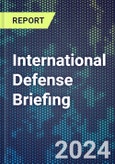Each country report includes information describing the basic details of the country's government, major factors affecting its defense posture, an inventory of its major weapons holdings, details of defense budget and expenditures including Foreign Military Sales (FMS) from the United States, and a survey of its major weapons acquisition programs. A defense budget and major equipment forecast is provided along with a publisher analysis explaining our rationale for the forecasts.
The world overview report contains a compilation of the budget forecasts. The program reports are organized in sections by region (e.g., Africa) and within sections, alphabetically by country name. Most of the countries of the world are covered in International Defense Briefing except for the United States.
Table of Contents
World Overview
- International Defense Budget Overview
The Americas
- Argentina
- Bolivia
- Brazil
- Canada
- Chile
- Colombia
- Costa Rica
- Cuba
- Dominican Republic
- Ecuador
- Guyana
- Haiti
- Honduras
- Mexico
- Nicaragua
- Paraguay
- Peru
- Suriname
- Uruguay
- Venezuela
Europe
- Albania
- Austria
- Belgium
- Bulgaria
- Croatia
- Czech Republic (Czechia)
- Denmark
- Estonia
- Finland
- France
- Germany
- Greece
- Hungary
- Italy
- Latvia
- Lithuania
- Luxembourg
- Netherlands
- Norway
- Poland
- Portugal
- Romania
- Serbia
- Slovakia
- Slovenia
- Spain
- Sweden
- Switzerland
- Turkey
- United Kingdom
Former Soviet Union
- Belarus
- Georgia
- Kazakhstan
- Russia
- Ukraine
Middle East
- Bahrain
- Egypt
- Iran
- Iraq
- Israel
- Jordan
- Kuwait
- Lebanon
- Oman
- Qatar
- Saudi Arabia
- Syria
- United Arab Emirates
- Yemen
Africa
- African Country Survey
- Algeria
- Angola
- Congo, Democratic Republic of (Zaire)
- Ethiopia
- Libya
- Morocco
- Nigeria
- South Africa
- Sudan
- Tunisia
Asia-Pacific
- Afghanistan
- Australia
- Bangladesh
- Brunei
- Burma (Myanmar)
- Cambodia (Kampuchea)
- China (People’s Republic of China)
- India
- Indonesia
- Japan
- Korea, North (DPRK)
- Korea, South (RoK)
- Laos
- Malaysia
- Mongolia
- Nepal
- New Zealand
- Pakistan
- Papua New Guinea
- Philippines
- Singapore
- Sri Lanka
- Taiwan (Republic of China)
- Thailand
- Vietnam
Appendix 1
- Appendix 1-World Arms Transfers
Appendix 2
- Appendix 2-FMS Contracts (FY21-Present)
Methodology
The publisher's analysts employ a combination of empirical and expert centered approaches to forecasting across multiple global defense and aerospace markets. Numerous variables play into future market requirements: macroeconomics, geopolitics, regional competitiveness, public and private market forces, cost pressures, country‐specific budget constraints, supplier relationships, etc.
We maintain proprietary databases that provide a strong foundation for building a quantitative understanding of key relationships between the forces that drive the demand for an array of products, platforms, and systems. These data assets have been developed and expanded over 30 years of company operations and provide an unapparelled set of resources that make the publisher uniquely qualified to forecast future industry performance. These empirical fundamentals allow for rigorous modelling.
In addition to this highly structured, data-driven perspective, the publisher through the expertise of its analysts has a comprehensive qualitative understanding of the forces that shape market demand. It is our position that forecasting demands both empirical understanding and artistic interpretation based on insights gained from decades of dedicated research and analysis. The result is a forecast that combines both to achieve a highly informed window to the future.

LOADING...








